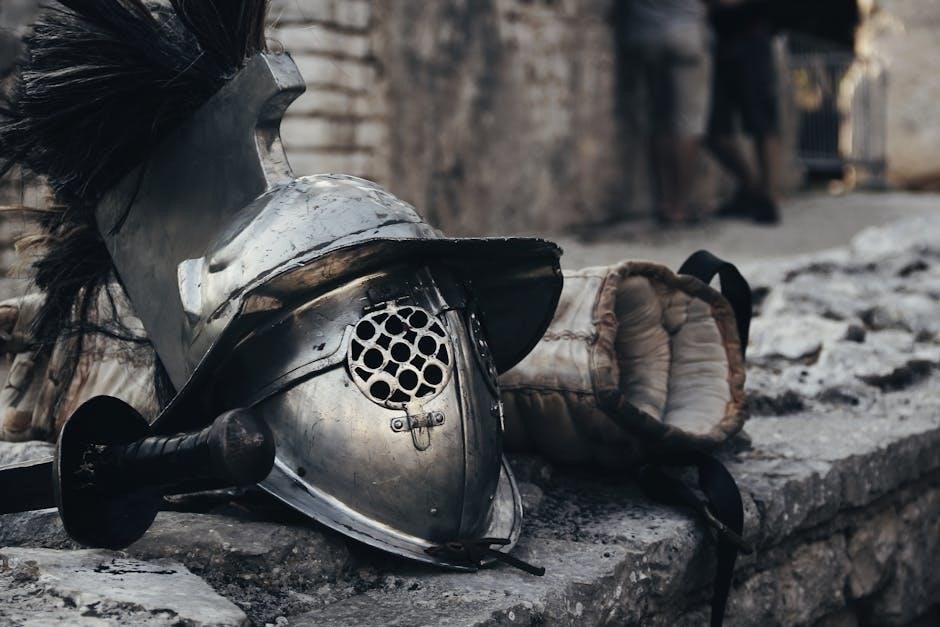Identifying Civil War swords involves understanding their historical significance, design variations, and unique markings. This guide provides insights into recognizing authentic weapons and their market value, ensuring collectors and historians can accurately trace their origins and appreciate their historical importance.
Historical Context of Civil War Swords
Civil War swords are deeply tied to the conflict’s history, serving as tools for combat and symbols of rank. Manufactured between 1861 and 1865, these weapons reflect the era’s military tactics and societal values. Officers often carried ornate swords, while enlisted men used functional cavalry sabers or infantry swords. The Civil War saw the rise of mass production, with manufacturers like Ames and Colt producing thousands of swords. Many swords bore inscriptions or markings, such as “US” for Union forces, aiding in identification. Confederate swords, often improvised due to resource limitations, differ in craftsmanship. Understanding this historical context is crucial for identifying and appreciating these artifacts, as it reveals their origins, usage, and significance in the war’s narrative.
Importance of Sword Identification for Collectors and Historians
Accurate identification of Civil War swords is vital for collectors and historians, as it ensures authenticity and preserves historical integrity. Misidentification can lead to incorrect attributions, affecting both scholarly research and market value. For collectors, identification helps distinguish genuine artifacts from reproductions, ensuring investments are worthwhile. Historians rely on accurate identification to reconstruct battles and understand the lives of soldiers. Proper identification involves analyzing blade markings, hilt styles, and provenance, which are critical for tracing a sword’s history. This process not only honors the past but also safeguards the legacy of these artifacts for future generations. By meticulously identifying each sword, collectors and historians contribute to a deeper understanding of the Civil War’s material culture and its enduring impact.

Understanding Civil War Sword Types
Civil War swords include officer swords, cavalry sabers, and infantry swords, each with distinct designs reflecting their intended use and the rank of the soldier wielding them.
Officer Swords: Characteristics and Variations
Officer swords from the Civil War era are distinguished by their ornate designs and symbolic engravings, reflecting the rank and prestige of their owners. These swords often featured intricatehilts, sometimes adorned with silver or gold plating, and were typically lighter and more ceremonial than those used by enlisted men. Many officer swords were custom-made, bearing inscriptions that honored the soldier or their unit. Manufacturers like Ames and Tiffany produced high-quality examples, often with unique blade etchings that included patriotic motifs or regimental insignias. While some officer swords were functional, others served primarily as symbols of authority, making them highly sought after by collectors today. Variations in design and craftsmanship can significantly impact their historical value and authenticity, making detailed analysis essential for proper identification.

Cavalry Sabers: Design and Usage
Civil War cavalry sabers were primarily designed for close combat, featuring a curved blade optimized for slashing; The most common model was the Model 1860 Light Cavalry Saber, characterized by its three-foot blade with a single edge and a distinctive curve. The hilt was typically made of brass, with a three-bar guard for hand protection. Sabers were often used by Union cavalry units, though their effectiveness in actual combat was debated due to the shift toward firearms. Manufacturers like Ames Manufacturing Company produced these sabers, often stamping their names and serial numbers on the blade. Many sabers also featured decorative elements, such as engraved officer names or regimental insignias. Their scabbards were usually made of leather or steel, with frog studs for attachment to belts. Today, cavalry sabers are highly sought after by collectors for their historical significance and craftsmanship.
Infantry Swords: Features and Historical Significance
Infantry swords during the Civil War were primarily sidearms for foot soldiers, designed for close-quarters combat. The most common type was the Model 1860 Cutlass, featuring a straight, single-edged blade with a rounded point, ideal for thrusting. Hilts were typically brass with a simple guard, designed for durability over aesthetics. These swords were often issued to infantry units but saw limited use on the battlefield, as rifles became the dominant weapon. Many cutlasses were produced by manufacturers like Ames Manufacturing Company, with markings indicating their origin. Infantry swords also served ceremonial purposes, such as in parades or presentations to officers. Their historical significance lies in their role as transitional weapons, marking the shift from traditional edged weapons to modern firearms. Collectors value these swords for their simplicity and the insight they provide into the evolving nature of warfare during the Civil War era.

Key Features for Identification
Identifying Civil War swords involves analyzing blade inscriptions, hilt styles, and scabbard details. These features help determine authenticity, manufacturer, and historical use, aiding collectors and historians in accurate classification.
Blade Inscriptions and Markings
Blade inscriptions and markings are crucial for identifying Civil War swords, offering insights into their origins and history. Many swords feature maker’s marks, such as “US” or “1863,” indicating the manufacturer and production year. Some blades bear patriotic phrases like “E Pluribus Unum” or regimental designations, adding historical context. Inscriptions often vary by sword type: officer swords might have intricate engravings, while cavalry sabers display functional markings. These details help trace a sword’s provenance and validate its authenticity. For instance, a blade stamped “USDR 1863” suggests it was produced for the U.S. military during the Civil War. Such markings are essential for collectors and historians to accurately classify and value these weapons, ensuring their historical significance is preserved.
Hilt and Guard Styles
The hilt and guard of Civil War swords are key identifiers, reflecting their intended use and historical context. Officer swords often feature intricately designed hilts with ornate brass or silverwork, sometimes adorned with patriotic motifs like eagles or flags. In contrast, cavalry sabers have sturdy, functional hilts with a single or double-braced guard, designed for durability in combat. Infantry swords typically have simpler, more practical designs, with brass or iron guards. The materials and craftsmanship of the hilt can indicate the sword’s origin and manufacturer. For example, swords made by prominent manufacturers like Ames or Tiffany often display distinctive hilt styles. These details not only enhance the sword’s aesthetic appeal but also provide critical clues for authenticating and dating the weapon, making them essential for collectors and historians alike.
Scabbard and Accessories Analysis
The scabbard and accessories are crucial for Civil War sword identification, offering insights into the weapon’s history and authenticity. Scabbards were typically made of leather or metal, with decorative elements like brass fittings or engraved designs. Swords issued to officers often had more ornate scabbards, while those for enlisted men were simpler. The presence of manufacturer marks or regimental insignia on the scabbard can help trace the sword’s origin; Accessories such as belts, frogs, and sword knots should also be examined, as they provide context about the sword’s usage and ownership. The condition and patina of the scabbard can indicate its age and authenticity. Collectors and historians must carefully analyze these components to understand the sword’s historical significance and ensure its legitimacy in a collection.

Advanced Identification Techniques
Advanced methods involve examining manufacturer marks, serial numbers, and provenance to authenticate Civil War swords, ensuring accuracy in tracing their historical origins and verifying their legitimacy.
Manufacturer Marks and Serial Numbers
Manufacturer marks and serial numbers are critical for identifying Civil War swords, as they reveal the maker and production details. Prominent manufacturers like Ames, Tiffany & Co., and others often stamped their names or initials on the blade or hilt. Serial numbers, though less common, can help trace a sword’s production history. These marks not only aid in authentication but also provide insights into the sword’s origins and rarity. Collectors and historians rely on these identifiers to distinguish genuine artifacts from reproductions. Over time, some marks may fade or corrode, requiring expert examination to decipher. Understanding these details enhances the appreciation of the sword’s historical significance and market value, making them indispensable in the identification process.
Provenance: Tracing a Sword’s History
Provenance, or the history of ownership, is a vital aspect of Civil War sword identification. It helps establish authenticity, value, and historical significance. Swords with documented provenance, such as those linked to specific soldiers, battles, or prominent figures, are highly sought after by collectors and historians. Tracing provenance often involves examining historical records, letters, diaries, and bills of sale. Museum archives, auction catalogs, and descendant testimonies can also provide crucial insights. A well-documented chain of custody enhances credibility and market value, making provenance a cornerstone of sword identification. However, gaps in records or incomplete documentation can complicate efforts to trace a sword’s past. Despite these challenges, provenance remains a powerful tool for uncovering the storied history behind these artifacts, connecting them to the broader narrative of the Civil War.
Mastering Civil War sword identification requires a blend of historical knowledge, attention to detail, and research. Explore museum collections, consult experts, and use reputable guides to enhance your understanding and authentication skills.
Step-by-Step Identification Guide
Begin by examining the sword’s overall condition and design. Inspect the blade for inscriptions, markings, or serial numbers, which often indicate the manufacturer or issue date. Next, analyze the hilt and guard for distinctive styles, such as the rounded guards of officer swords or the sturdy designs of cavalry sabers. Check the scabbard for metal type, finish, and any decorative elements. Research the manufacturer’s marks, as companies like Ames or Tiffany often stamped their products. Investigate historical records or provenance to trace the sword’s history. Finally, consult experts or reference materials to verify authenticity and determine the sword’s type and era. This systematic approach ensures accurate identification and appreciation of the weapon’s historical significance.
Authenticity Verification and Market Value
Authenticating a Civil War sword requires meticulous examination of its features, historical documentation, and provenance. Experts often verify the blade’s condition, patina, and any inscriptions or maker’s marks. The presence of original scabbards and accessories can significantly enhance authenticity. Market value is determined by factors such as rarity, condition, and historical significance. Swords with documented battle use or ties to notable figures command higher prices. Collectors should consult reputable appraisers or auction houses to assess value accurately. The market for Civil War swords remains robust, with high-quality examples fetching substantial sums. Ensuring authenticity is crucial to preserving the sword’s historical integrity and monetary worth, making expert verification an essential step for collectors and historians alike.